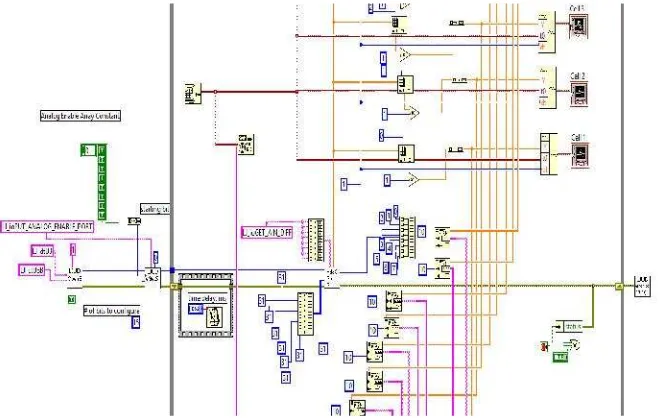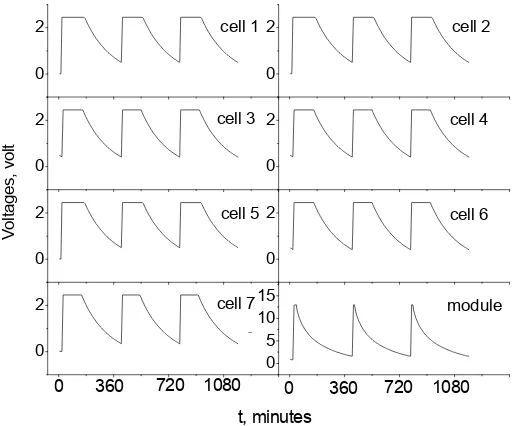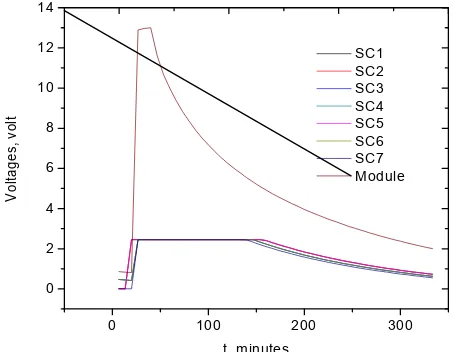DOI:10.12928/TELKOMNIKA.v14i4.3994 1307
Multichannel Data Aquisition System for Monitoring
Supercapacitor Module and Cells
Nirwan Syarif1*, Assaidah2
1
Department of Chemistry, Faculty Mathematics and Natural Science, Universitas Sriwijaya, Indonesia
2Department of Physics, Faculty Mathematics and Natural Science, Universitas Sriwijaya, Indonesia
*Corresponding author, e-mail: [email protected]
Abstract
The monitoring system is needed to observe changes in the voltage of supercapacitor module and cells so that their performance can be assessed. A multichannel data acquisition system was needed to implement because a module of supercapacitor consists of several individual cells. The system can be implemented in a computer program using data acquisition board and computer programming. The computer program acts as computer and user interface was created by using Labview symbolic programming software, while the data acquisition board was Labjack. The test showed that the monitoring system can receive eight channel of input signal (voltage) of the module and cells simultaneously. The voltage of the module which has a wider range, 0-20 volts, rather than the normal input, 0 to 2.44 volts, can be overcome by adding a voltage divider circuit.
Keywords: Supercapacitor, Labview, Labjack, DAQ, Programming, Instrumentation
Copyright©2016 Universitas Ahmad Dahlan. All rights reserved.
1. Introduction
Data acquisition is a process used to collect information to document or analyze some phenomena [1]. A simple example of data acquisition system is logging the temperature of an oven on a piece of paper. As technology move forward, this type of process has been simplified and made more accurate, versatile and reliable through electronic equipment [2]. A multichannel from single data acquisition system has been built which is connected to a computer in the same way as any other equipment for example scanner and printer [3], [4]. This system can be used to monitoring special events, tasks and devices, just like as in supercapacitor module and its cells [5].
Supercapacitor (SC) has become important device as power support in electric vehicles or and in renewable energy systems [6]. SC has longer life time and faster in charge time compare to battery [7]. However, module with two or more SCs suffered imbalanced voltage distribution [8, 9]. Some SCs will have an overvoltage that will be associated with the decrease of the lifetime. For the other SCs, the maximum voltage will be undervoltage therefore the energy storage in SCs will not be at its maximum level. A SC with a low capacitance has shorter charging time and, thus, reaches its maximum voltage faster than SC with high capacitance. This situation is unacceptable, because it would cause damage to the module. To avoid damaging, voltage equalization/stabilization component have to be employed in each cells [10]. The other problem is in the making of the electrode, the precursors are derived from various carbon materials so that the SC has a diverse electrical properties [11]. Considering the two problems, therefore, a multichannel monitoring system is needed in efforts to study the properties of SC cell or to develop module of SC with maximum performance.
TELKOMNIKA Vol. 14, No. 4, December 2016 : 1307 – 1312
The monitoring system was implemented through the computer, and the obtained data are stored in the computer memory, plotted on the screen and recorded on the disk as a file. The file data are available for offline processing. The main part of the monitoring system is data acquisition board, i.e. Labjack. Information about the applications of Labjack in acquiring data can be found in some papers [13-15] That can be received signal as voltage, i.e. 0 – 2.44 volt with 4 – 500 mA of current.
The complexity of the method demands the setup a simultaneous control or monitoring of various devices, and much time must also be devoted to post-data treatment and analysis. The development of this method for its application as a standard tool in electrochemical research and development, Therefore, LabVIEW was used to overcome these difficulties and needs. LabVIEW is a general purpose programming environment with high level programming languange [16] and has been established in electrochemical research as a control, data acquisition and analysis software [17]. In this paper, we present a description of the construction of multichannel monitoring system to investigate the supercapacitor cells and module using LabVIEW. The setup allows the data acquisition board, Labjack to be probed simultaneously charge and discharge rate of supercapacitor.
2. Research Method 2.1. Hardware description
Intel Pentium i3 PC was used for monitoring interface and part of data acquisition system. Synchronizing between digital and analog signal was provided by DAQ board (Labjack U3-LV). The DAQ board can be interfaced to PC by using USB hub providing multiple I/O channels, i.e. 8 flexible I/O (digital input, digital output, or analog input), 4 digital I/O channels, 2 counter/timers channels and 2 channels 10-Bit analog outputs. The circuit works at low–level current signal ranging from 4 to 100mA and low voltage ranging from 0 to 2.44 volt.
Figure 1. The Interface Programming for Monitoring Voltage of SC Module and Cells that acquired by using Labjack Data Acquisition Board
2.2. Software Description
user interface by using a set o the actual user-friendly instru initialize USB communication from the power supply, SC m form; 4) set the sampling ti separator value) format. Figu acquire the data. independent influences on e responses from each superca
Figure 2. Screenshot of Pro
t of tools and objects. The user interface is known a graphical representations of functions to contro contains this code. As an example, the Block Dia howed for the characteristic electrochemical me adjusting the values of the operation parameters, i. ing the data.
for supercapacitor data acquisition is a very importa tion for particular application. The main feature of th ecessity to the numerous measurement signals. Th e components that do not create their own signa fact the supercapacitor data acquisition system s each data acquisition channel and then colle capacitor.
TELKOMNIKA Vol. 14, No. 4, December 2016 : 1307 – 1312
One of special problem in developing and applying SC is complexity of making the module from SC cells and it is much harder to connect SCs compare than batteries because of the characteristics of electrode precursors [18]. In general, individual cell of SC has bias voltage about 2.5 volts since the power supply gives 25 volt to simulate the factual voltage to the module. Therefore, it needs serial and parallel connection in order to match with given voltage. The module needs extra components in order to work best and to have longer lifetime. In the other hand, the normal input range for a low voltage channel on the U3 is about 0-2.44 volts. The easiest way to handle larger voltages is often by using voltage divider circuit (Figure 3), which is a two channel buffered divider module that plugs into the U3 screw-terminals.This divider is easily implemented by putting a resistor (R1) in series with the signal wire, and placing a second resistor (R2) from the AIN (analog) terminal to a GND (ground) terminal. To maintain specified analog input performance, R1 should not exceed the values specified in Labjack manual, so R1 can generally be fixed at the max recommended value and R2 can be adjusted for the desired attenuation.The divide by 2 configuration where R1 = R2 = 10 kohm (max source impedance limit for low-voltage channels), presents a 20 kohm load to the source, meaning that a 5 volt signal will have to be able to source/sink up to +250 µA. Some signal sources might require a load with higher resistance, in which case a buffer should be used. Labjack is then ready for use in monitoring the data from the SC module.
Figure 3. Voltage Divider Circuit for Reading 0 – 20 volts Input from SC Module and Cells
Figure 4. Receiving Actual Data while Charging Discharging Process in Cells and Module
LabVIEW to record digital data that has been issued by the signal generator.The provision of digital data will be compared to LabVIEW between a given frequency signal generator with a frequency that is captured by LabVIEW. From digital input test results will be obtained Labjack digital input with a maximum frequency of how that can be acquired by Labjack this alternative. Testing was done by giving the variation frequency of the signal box to Labjack and displayed by LabVIEW, given the variation was 1Hz and above. The results showed that the monitoring system was done well in monitoring eight giving signals (voltages). Figure 4 shows the input test of monitoring test.
All these logged data are recorded in the tabular form also which can be seen when log button is clicked. The data can be recorded in csv or txt format. Following parameters are recorded with actual date and time, seven channels for cells voltage, one channel for module voltage. The update rate of these data depends upon the time set in milliseconds. The content and structure of data log file can be is shown in Figure 5.
Figure 5. The content and structure of data log file generated by the monitoring software
The logged data can be analyzed and represented in different forms. In the similar way graphical representation of other logged parameters are also displayed like current with time, array voltage data versus time, discharging versus time. Figure 6 shows graphical representation of module and cell voltage versus time.
Figure 6. Representation of voltage changes as function of time in SC module and each cells during charging discharging process
It is clear that the implemented system can do the acquisition task. The use of low cost data aqcusition system will facilitate the spread of the measurements both cells and module, thus allowing recognized individual SC as part of solar panel and wind power generation.
0 100 200 300
0 2 4 6 8 10 12 14
V
o
lta
g
e
s,
v
o
lt
t, minutes
TELKOMNIKA Vol. 14, No. 4, December 2016 : 1307 – 1312 4. Conclusion
Monitoring system for supercapacitor data acquisition is a very important factor to solve the task of system optimization for particular application. This paper has presented a description of the construction of multichannel monitoring system to investigate supercapacitor cells and module using Labjack data acquisition board and LabVIEW programming language. Developed multichannel monitoring system was successfully used to evaluate voltage changes in supercapacitor module and cells.
Acknowledgements
The authors wish to express deep gratitude to the Lemlit Unsri for the financial support provided to this work underHibah Unggulan Kompetitifscheme 2015.
References
[1] R Adhikary, M Chakraborty, B Dara, A Bharti, S Mukherjee. FPGA based data acquisition and data
monitoring system. In Radar, Communication and Computing (ICRCC), 2012 International
Conference on. 2012: 250-253.
[2] B Gunawan, M Rivai, H Juwono. Characterization of Polymeric Chemiresistors for Gas Sensor.
TELKOMNIKA Telecommunication Computing Electronics and Control. 2012; 10(2): 275-280.
[3] M Antler, E Salin, G Wilczek-Vera. An Undergraduate Experiment in the Advanced Analytical Chemistry Laboratory.J. Chem. Educ.2005; 82(3): 425.
[4] DR Santoso. A Simple Instrumentation System for Large Structure Vibration Monitoring.
TELKOMNIKA Telecommunication Computing Electronics and Control. 2010; 8(3): 265-274.
[5] Y Lina, Z Qianfan, L Zheng. Control and Data Acquisition of Super Capacitor Energy Storage Elevator System. 2013: 1507-1512.
[6] AM Jarushi, N Schofield.Battery and supercapacitor combination for a series hybrid electric vehicle. in 5th IET International Conference on Power Electronics, Machines and Drives (PEMD 2010). 2010: 151.
[7] P Thounthong, S Rael, B Davat. Control strategy of fuel cell/supercapacitors hybrid power sources for electric vehicle.J. Power Sources. 2006; 158: 806-814.
[8] YC Zhang, L Wei, X Shen, H Liang. Study of Supercapacitor in the Application of Power Electronics.
WSEAS Trans Cir Sys. 2009; 8(6): 508-517.
[9] R Kötz, JC Sauter, P Ruch, P Dietrich, FN Büchi, PA Magne, P Varenne. Voltage balancing: Long-term experience with the 250V supercapacitor module of the hybrid fuel cell vehicle HY-LIGHT. J.
Power Sources. 2007; 174(1): 264-271.
[10] E Oyarbide, C Bernal, P Molina, LA Jiménez, R Gálvez, A Martínez. Voltage equalization of an ultracapacitor module by cell grouping using number partitioning algorithm.J. Power Sources. 2016; 301: 113-121.
[11] P Simon, Y Gogotsi. Materials for electrochemical capacitors.Nat Mater. 2008; 7(11): 845-854. [12] V Martynyuk. Supercapacitor Data Acquisition Systems. 2007: 24-28.
[13] T Lund-Olesen, M Dufva, JA Dahl, P Collas, MF Hansen. Sensitive on-chip quantitative real-time PCR performed on an adaptable and robust platform.Biomed Microdevices. 2008; 1: 1-8.
[14] AM Sadeghioon, N Metje, DN Chapman, CJ Anthony. SmartPipes: Smart Wireless Sensor Networks for Leak Detection in Water Pipelines.J. Sens. Actuator Netw.2014; 3(1): 64.
[15] J Coronado, B Tartakovsky, M Perrier. On-line monitoring of microbial fuel cells operated with pulse-width modulated electrical load.J. Process Control. 2015; 35: 59-64.
[16] A Prayitno, O Kubumwe, H Bosma, E Tazelaar. Efficiency of Polymer Electrolyte Membrane Fuel Cell Stack.TELKOMNIKA Telecommunication Computing Electronics and Control. 2011; 9(2): 303-310. [17] M Nesselberger, SJ Ashton, GKH Wiberg, M Arenz. Design, development, and demonstration of a
fully LabVIEW controlled in situ electrochemical Fourier transform infrared setup combined with a wall-jet electrode to investigate the electrochemical interface of nanoparticulate electrocatalysts under reaction conditions.Rev. Sci. Instrum.2013; 84(7): 74103.



